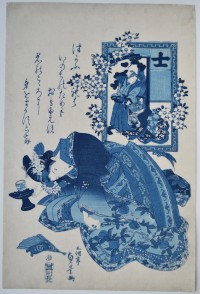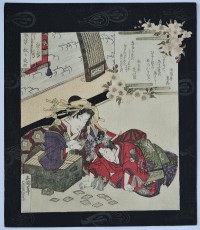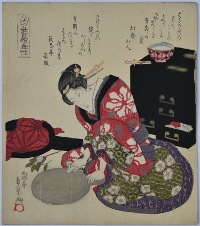Utagawa SADAKAGE (Fl. c. 1818-1844)

Click here to view image full size.
An aizuri-e (blue print) showing a beauty bowing obsequiously with a cup of tea. Shi, “Samurai” from a set of the Four Estates: Shi, Samurai; No, Peasant; Ko, Artisan; Sho, Merchant. Published by Kawaguchiya Chozo, c. 1830s. These blue prints using the imported bero, Berlin blue (what we called Prussian blue), became popular during the 1820s to 1840s as the cost came down.
Very good impression, colour and condition. Signed Gokotei Sadakage ga.
Status: Available
Utagawa SADAKAGE (active c. 1818-1844)
Click here to view image full size.
A surimono, Kinsei, “Metal” from Gobantsuzuki, “A Set of Five” surimono based on the five elements: Wood, Fire, Earth, Metal and Water. Shows a woman polishing a metal mirror. Published c. mid-1820s. The set was designed for a group led by the poet Shakuyakutei whose plum-blossom emblem is seen at the top of the title cartouche.
Superb impression, colour and condition. Extensive silver and gold. Mint condition. Signed Gokotei Sadakage ga.
Status: Sold
Utagawa SADAKAGE (Act. c 1818-1844)

Click here to view image full size.
A surimono showing a courtesan and her acolyte playing a Hyakunin Isshu version of uta-garuta, a card game where a hundred poets are matched to a hundred poems. Karasaki: Night rain on a festival day from a set of surimono Kuruwa hakkei, “Eight Views in the Licensed District [the Yoshiwara].” The Eight Views theme , which came from China, was embraced by ukiyo-e, firstly depicting landscape views but then extended to cover accomplishments or moments of the day, usually associated with fashionable beauties. The set issued by the Biwaren Poetry Club in 1832. Their stylised symbol – the biwa – appears in the border.
Very fine impression and colour with gold, silver and blind-printing. Very slight crease, otherwise fine condition. Signed Gokotei Sadakage. Rare.
Status: Sold
